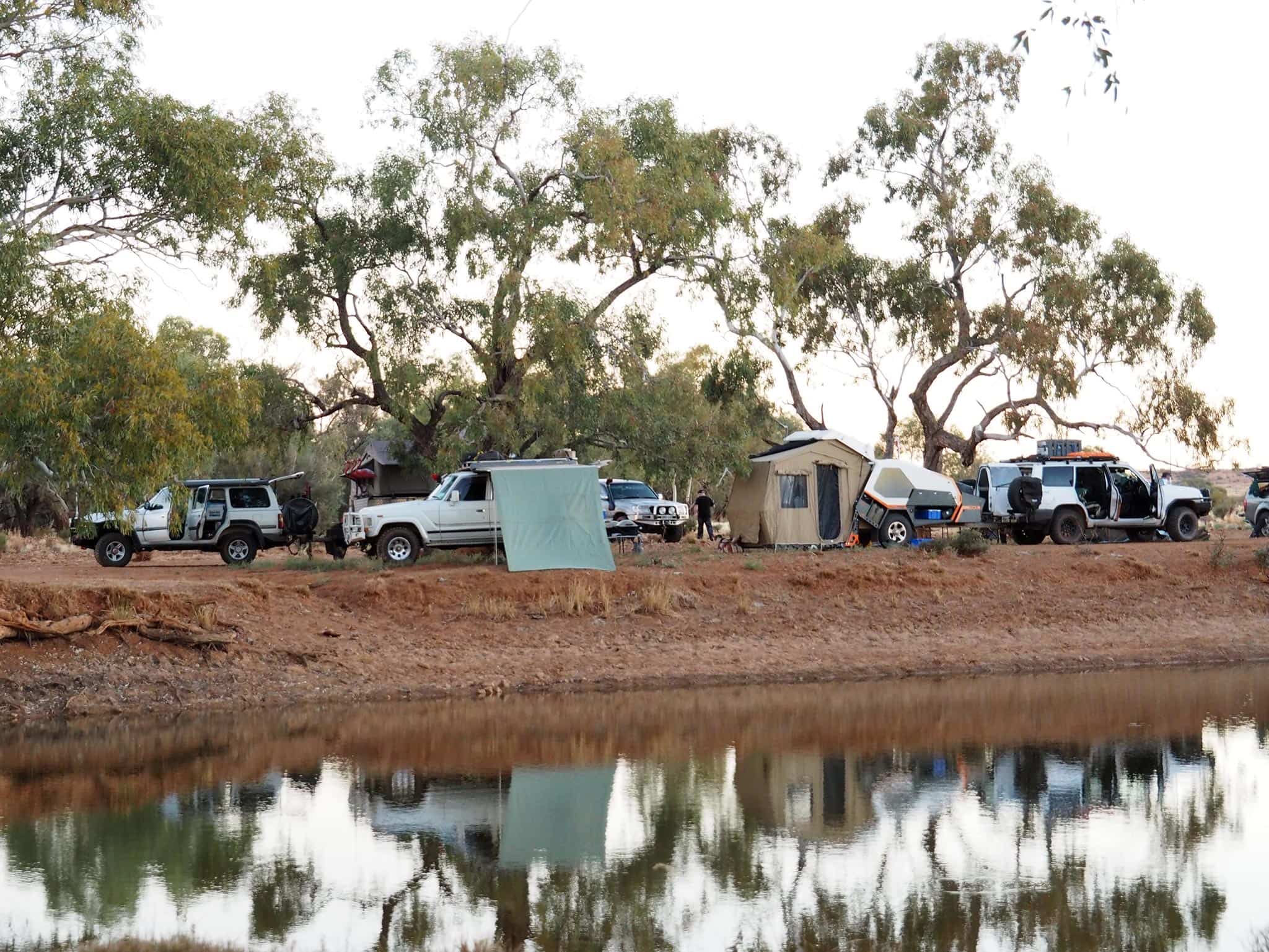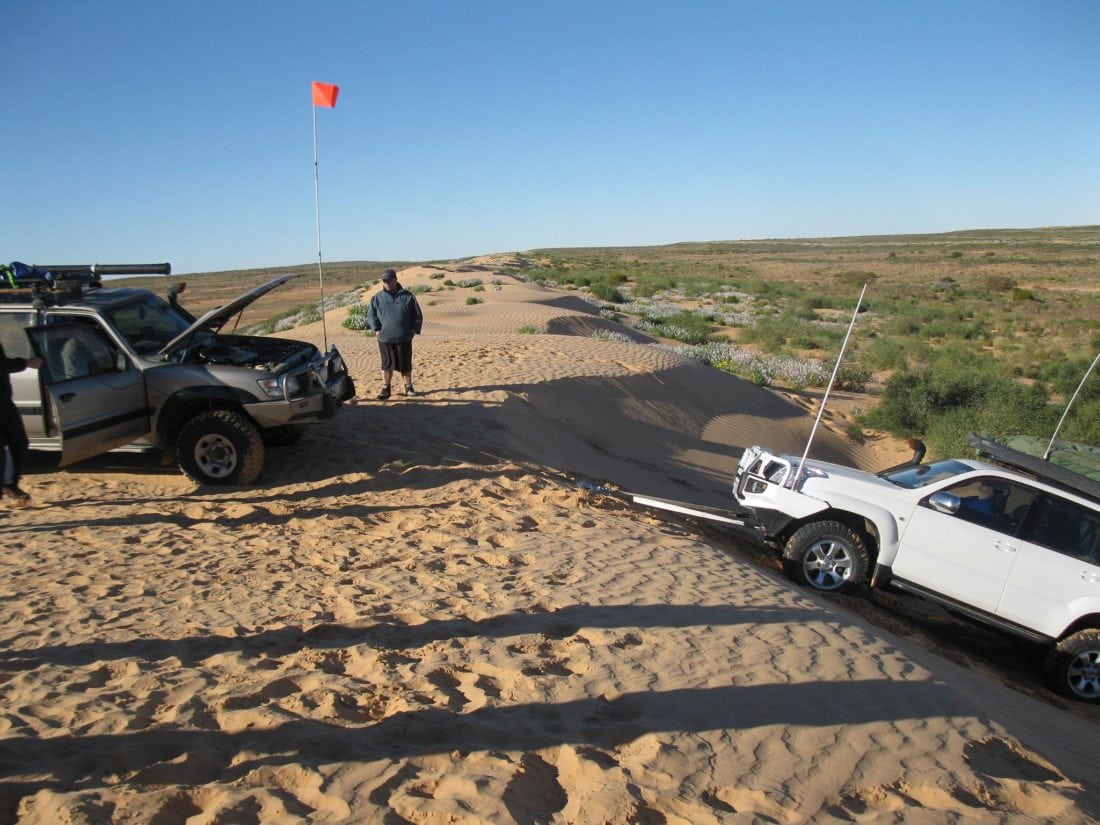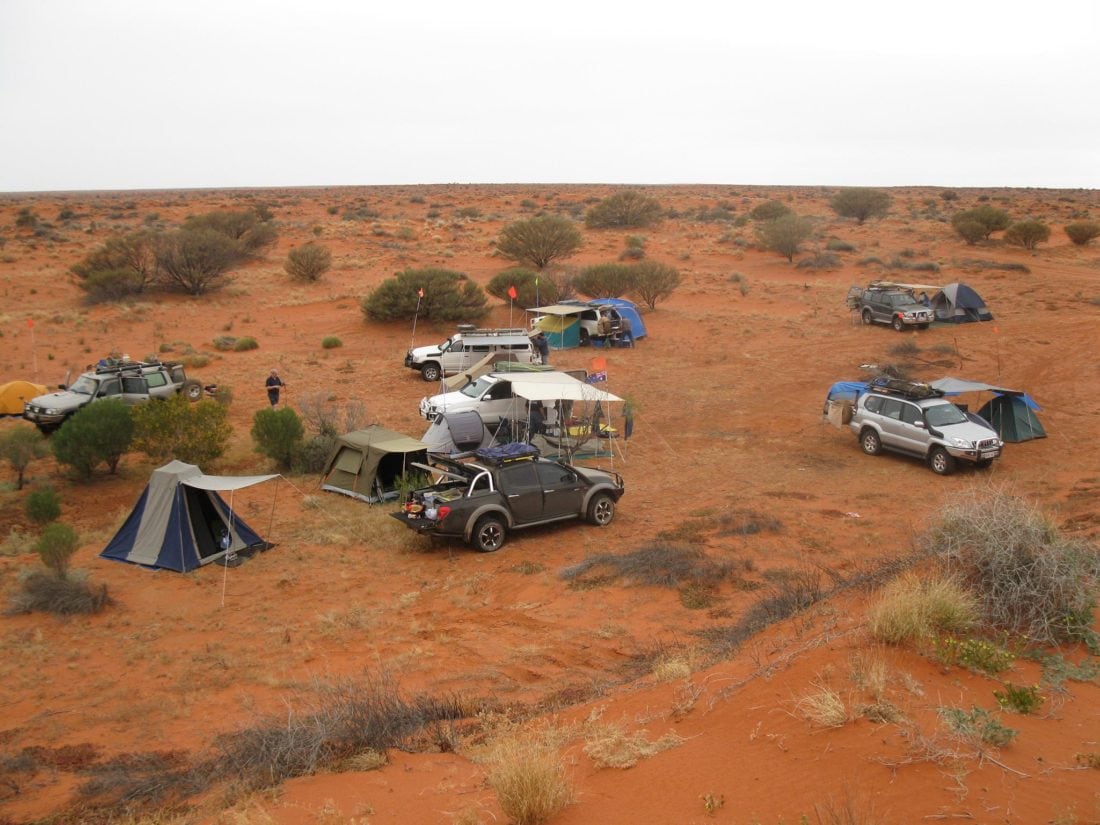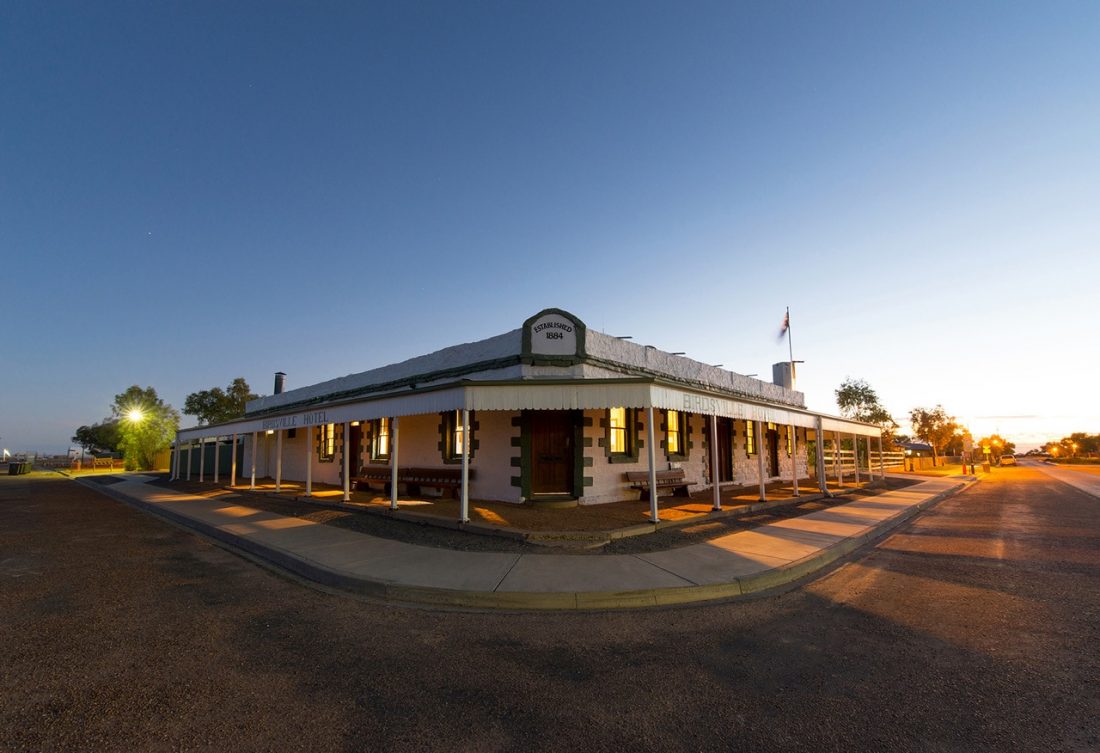From cracking backs to outback tracks
Former chiropractor Steve Brown has had an affinity with the outback since his parents first took him and his two siblings across the Simpson Desert in a FJ40 short wheel-based Land Cruiser in the early seventies. Now retired, Steve is a regular visitor to the outback and a seasoned traveller on The Outback Loop having completed all three Loops — the most recent being in June last year.
The Outback Loop® caught up with Steve to ask him what keeps drawing back to the South Australian outback time and time again.
The Lure of the Outback
Interviewer: Steve, what lures you to the Outback?
In 1974 Mum and Dad bought a little short wheel base FJ40 Land Cruiser after borrowing my uncles, and just fell in love with this thing that went up and down hills and places it shouldn’t be able to go. So, through the 70s, we travelled as a family of five: Mum, Dad, and my brother in the front, and my sister and myself in the back on the troop seat — the troop carrier seat where you sit sideways.
I grew up in an era where we had powdered milk, and tins of food, and we soon learned that you can’t just leave the tins of food on their own, the labels wear off and then you don’t know what the heck you’re eating. Whereas now, we have beautiful fridges and freezers, and we go away and take gourmet food, by comparison.
Interviewer: So, how many times have you been to the Outback?
I’ve done the Simpson Desert three times, I’ve been into the outback on other trips where we’ve just done Innamincka and places like that. So I’ve had probably five or six now, major trips that were on these sort of iconic tracks, over the last few years. Of course, with working I wasn’t always able to get away as much as I’d like to, but now I have more of an opportunity to do that. So, yeah it’d be five or six times, but I’m talking right out in the Outback. The Flinders Ranges and so on, I’ve done many a time, but that’s not as remote as the Outback Loop.
Exploring the Outback Loop
Interviewer: And you were up there as recently as 12 months ago?
Yes, not even 12 months. It was June last year, 2018. We did a trip across Simpson Desert with a group of six vehicles and two people in each vehicle: some people had camper trailers, some of us swagged it.
I actually went up with a friend of mine who wasn’t confident. He hadn’t ever done it before, and he didn’t want to be driving on his own, so I actually went up and rode shotgun with him, if you like. We shared the driving a bit, and it was good for him because it was his first experience, and he didn’t really want to do it all on his own, which is fair enough.
Interviewer: So what route did you take? Did you go up through Marree?
We met up with our friends at Port Augusta. Keith and I left early and we stayed at Melrose for the night. And then we went out through Lyndhurst, Marree, William Creek and then on to Oodnadatta up to Mt. Dare and then across to Birdsville, and then we came back down the Birdsville Track through Mungerannie, back through to Marree. Then we had a little detour…we actually went off into the Flinders Ranges and had a couple of nights there on the way back.
Interviewer: Have you been any other way?
Yes, we’ve also gone up through the Flinders and up through Arkaroola and the Gammon Ranges, and then up to Innamincka, and exploring all around the area there. Yeah, that was sensational doing that.
Oh, and I tell a lie, last time instead of coming down Birdsville Track, we then came down through Cordillo Downs, through the station at Cordillo Downs, and then to Innamincka, and then came home that way via the Strzelecki Track. That’s right.
Interviewer: So you’ve really done…well, we divide The Outback Loop into three tracks. There’s the big loop, then there’s the left inside loop, and then the right one is what you just described then, which is Cordillo Downs, Innamincka, Marree, Birdsville loop. So you’ve done all three of them?
Yes, yep.
Bird Life in the Simpson Desert
Interviewer: So, tell us about some of the experiences…the sort of the things that you’ve seen, done, experienced on The Outback Loop.
I was very fortunate. I went up in 2010, and it was after there had been huge rains earlier in the year. So, we were leaving towards the end of June on this trip, and back in about January or February, might have even been March…Birdsville had actually received 200 mm of rain in two days. They had something like 140mm one day, and another 60 the next, and the whole of central Australia was an absolute soak.
And for all the years that my folks had done these trips, this was the first time (I had experienced flooded conditions)…we nearly looked like we weren’t gonna be able to go, because you couldn’t actually get across the Eyre Creek, which feeds into Lake Eyre. Even the bypass road was impassable, because it was two and a half meters deep, so you can’t drive a four-wheel drive through that.
Anyway, it was only … seriously, week and a half or two weeks before we were scheduled to leave, that it had opened up. So we drove through the desert and, I have photos where the trip leader…I remember the trip leader saying, “Hey, anyone got their lawnmower with them? You wait ’til you come over and see this next swale”. The swale in the valley between the sand dunes just looked like Adelaide Oval. It was incredible, and it sounds like I’m exaggerating, but it was absolutely amazing.
And then we saw ducks.There was so much water lying there that there was a pond that would’ve been about the size of probably half a football oval, that had, conservatively, four to five hundred ducks on it. And the (other) bird life was incredible. The flowers, the wildflowers were just astronomical.
Every dune just had this line of green and white and yellow blossom on it, and it was incredible. And every time you stopped and just have a ’code yellow’, you could see little critters’ footprints. There was so much life in the desert because of all this growth, it’s the cycle of life.
On that particular trip, the Birdsville Track was still closed south of Mungerannie, so we had to go on to Etadunna Station. There’s actually a ferry that goes across the Cooper Creek, and it hadn’t been used since 1990, because the Cooper hadn’t flowed for 20 years, and when we were there, it was flowing. So they had this very archaic, jerry-rigged, one-vehicle ferry that was operated by just two outboard engines, and you drove your car on, and they took you across, and they come back and then pick up the next one.
Anyway, we went on that, and that particular trip we were lucky enough that a guy who ran a birdwatching-cum-Cooper Creek Experience boat at Innamincka, happened to move his vehicle up to this place where the ferry was, he only arrived there the day before. And then when he negotiated with us, he said “Are you interested in doing a run in the boat?” and we said “Well, we’d have to do it early.”
So we arrange to meet him at about six in the morning, and we took off on the boat with the sun just coming over the horizon and we saw … I think we had about 80 species of birds that he recorded, and he said there’s still another 40-odd to go that aren’t here yet and he was very knowledgeable. So that was the best 50 bucks I’ve ever spent. We were on this thing for an hour and a half, on this boat, and it was the most amazing experience, and we were so lucky to do this.
So that was my first experience of it. Then when I went across to the Simpson the next time, it was, we hadn’t had the rains like that so it was really noticeable just how much drier it looked. It wasn’t, I suppose … it was more what I was expecting it to be the first time. You expect, it’s a desert, it’s going to be dry. When I saw it, it look so lush, it looked like an English country garden. So the two times I’ve been there since, it’s been drier. We had a few blossoms and wildflowers there last time, last year. But the one before, there wasn’t as many.
So, look, we’ve got the animal life, there’s just … what I like is that you have a campsite, and you pull up somewhere, and you don’t, there’s no other campsites near you. You just pull off to the side of the track, you find a spot, enough to fit your cars in and your camping arrangements, and it’s just so quiet. And it’s nice too, even we get a fire going, we take wood with us and sit around the fire, and have a nice meal, and then just enjoy how quiet it is. And very rarely is it windy overnight, it’s generally very still. How quiet it is, is just amazing.
More than just a Desert
Interviewer: I was talking to a guy a couple of days ago, and he said, “You get out there, and whatever perception you have of stars, is totally blown out of the water.”
Absolutely! When people have a go at me because I camp, and I might be in anything from a swag to a nice camper trailer, and they go, “Oh nah, it’s all five-star for me.” I say, “Only five stars? I camp under a million stars”. And that’s the thing, it’s just like this sky aquarium or something.
And honestly, you lie back on your camp chair and look up and you can see satellites going across, shooting stars, and the Milky Way is milky. It’s absolutely breathtaking, it really is breathtaking. And I never get sick of that. I never tire of that one little bit. Because there’s no radiant light from the ground, there’s no buildings and lights anywhere, so it’s just fantastic.
Interviewer: Would you recommend it to people who haven’t done it before?
Absolutely. Look, it’s really interesting. I’ve grown up with four-wheel driving, so I’m sort of knowing what to expect to a large degree. But when I’ve spoken to people who have had a chance to do something. They’ve either gone and gone on a Tagalong tour or they’ve actually gone in an organised thing. And I’m talking people who are the last people I would’ve expected to go to something, to a remote area.
My wife’s cousin had the preconception was that it was just going to be this horrible desolate desert, and didn’t think it was gonna be too much that was going to be very interesting. Now, she can’t wait to go back. And since then, they’ve gone on another trip, and they’ve even gone and done Cape York since then.
And this was … she had no desire, and I’ve heard of this a few times now, a number times, when people have not been thinking anything good about it at all, and they’ve gone there kicking and screaming almost, and yet they’ve absolutely loved it.
Interviewer: Well, that’s the perception isn’t it? People think that, “If I’m going to the outback, it’s just gonna be sand and desert and heat and … but it’s far from that.”
No, it’s far from that.
The perception is that it’s just this desert, and it IS a desert, but they’re thinking it’s just gonna be sand. But there are trees, and there are areas where you come across the riverbeds and so on, right out in the middle of the desert. But it’s always changing, and what you’re looking at, you can have big dunes, and you can have small dunes, and you can come across a big dune, and you can see for kilometres, all these dunes just going off in the distance.
Interviewer: What about wildlife?
Camels… you’ll see a lot of camels. If they happen to be on the track, and they often are, or near the track, they will then decide to run on the track. And because it’s a clear run, they just keep running.
And the problem is, you want to get past them and you want to keep moving, and you don’t want to make them have a heart attack because they’re running too hard. But if they just pulled off to the side we could all go past, but they’re not the cleverest of things, and they’ll just keep running and running and running. And sometimes it’s a bit inconvenient.
We’ve also seen dingoes, we’ve seen foxes and obviously all the bird life, I’ve mentioned before. And lizards … but all the time I’ve gone across, I’ve never seen a snake out there.
Interviewer: Really?
Yeah, never seen a snake.
The Iconic Pubs of Birdsville and Innamincka
Interviewer: Well, what we haven’t talk about yet, is pubs.
And that’s the most important thing.
Interviewer: It is.
Yeah, you gotta food and water yourself. Look, I suppose Birdsville pub, turning up there…
Interviewer: Iconic?
Iconic. Absolutely iconic. To pull up into Birdsville when you’ve come from Big Red and you see the racecourse and the aerodrome, and then there’s the pub, and there’s the bakery. And we pull up and have a shower, because we hadn’t had a proper shower for a number of days. We’ve had a bit of a wash in places, bit of a swim at Dalhousie Springs a few days earlier.
Having a cleanup with wet wipes sort of gets you across the desert, but it was nice to have a nice hot shower at Birdsville, so we had a shower, put on some clean clothes, and went over to the pub. And I’ll tell you what, even if you’re not a beer-drinker, the taste of that first beer when you’re in the pub is unreal. It was a warm day and it was sunny, and we were in there and it was so nice and cool.
And of course, in the pub you’ve got all the hats from all the different stations around the areas, and they’re all crusty looking and sweaty and that, and they’re all hanging up, they’ve all got their names there, and the people are involved and these other flags and different events that’ve been held over the years. Their banners are up on the roof, or up in the ceiling, and that sort of thing.
And we’ve had the best meals there.
Same with Innamincka. When we went up to Innamincka in 2017, and the Big Red Bash was on about a fortnight later. And we were at Innamincka and they’d only had about six or seven millimetres of rain, but it closed all the tracks. So, all these people were camped at Innamincka who were on their way up (the Big Red Bash), and all the campgrounds were chockers.
And then the rain came, but thankfully the at the pub they had this … I can’t remember her name, but they had this girl, this country singer, and her band there, and she was just fantastic. But we had another day, we went there for lunch and we sort of kicked on a bit in the afternoon, we ended up staying there for tea, as well. It was so good. We had some wonderful meals there, as well.
You’ve got the trading post there, right next door to the pub at Innamincka. So you need your food and your fuel, and your drinks and stuff. It’s all there. But yeah, both hotels cater really well for big groups of people. It’s not like if any more than 20 people turn up, they’re in strife. The Innamincka pub’s got a huge dining area. Yeah, and very modern facilities and it’s very, very nice.
We’ve had some great times, with some great music and good company. We met all these people who were on their way up to the Big Red Bash. They’re all in that anticipation mode, too. But we got talking with these guys, and we had a beaut time with them, because they had a common interest in the Outback and was good.
Interviewer: Any others, like Marree or Mungerannie?
Well I suppose, a very interesting one was when we were on our way down the Birdsville track, the Mungerannie Hotel, Phil there at Mungerannie, is quite a character.
Marree of course, there’s the museum there for Tom Kruse, which is really interesting to go through, a good audio-visual sort of thing. And of course there’s the train history from The Ghan and everything, the Old Ghan. And obviously we’ve done the Prairie Hotel and we’ve had the trio of feral food or whatever they call, what do they…?
Interviewer: Feral platter?
Feral platter, or whatever it is, yeah. We’ve got a great little bakery in Copley on our way down. But even, there really good, great places to camp at various places on the way. William Creek, we’ve eaten there, of course, and we stayed there. We camped there last time, as well. I think Innamincka and Birdsville still … they’re sort of, really-
Interviewer: The standouts?
They’re the standouts, they’re the real standouts, there’s no doubt about that. Yeah.
The Outback draws you back again and again
Interviewer: So, any plans to go back?
Yes. It’s highly likely we might even get back this year. I’m certainly going up to the Flinders Ranges and doing a trip there in a few months. But, absolutely. It’s one of those things that you never tire of because there are different ways of going. Like I said, I’ve been there in the rain, not when it’s raining but after it’s rained.
We’ve done different tracks to come back and different ways to go. And the group I’ve done it with have been primarily the same group of three or four vehicles or couples, and there has been some extras in amongst it. So, as I say, we have gone up and come back three different ways now.
And the one that I want to do is to go from east to west, because that’s actually a little more difficult as far as the dunes go. So you start at Birdsville, and make your way across to west. Because the winds primarily blow from the west, there’s a bit of a sawtooth arrangement, so the dunes are steeper on the eastern side, so it means it’s somewhat easier, because you tend to go up and then you drop off and then go down the steep side.
So it’s a bit more of a challenge to go the other way and it’s something I’ve not done, so I’d like to do that. That’s just another way of doing it, again. You do all your prep and you stock up at Birdsville and then refuel at the other end at Mt. Dare.
So yes, there are plans to do it. Nothing concrete at this stage, but it doesn’t take too long to get ourselves into gear. Most of us are prepared, there’s not too much preparation. It’s more people getting time off from work, say, and vehicle preparation. The rest of your gear you can throw in your vehicle with fairly short notice.
And vehicle preparation is very important. That way you minimise the likelihood of getting stranded, or having any problems, and just having spare belts and hoses and fluids, and you can minimise the likelihood of being stranded.
Interviewer: Excellent. Thank you, Steve.





